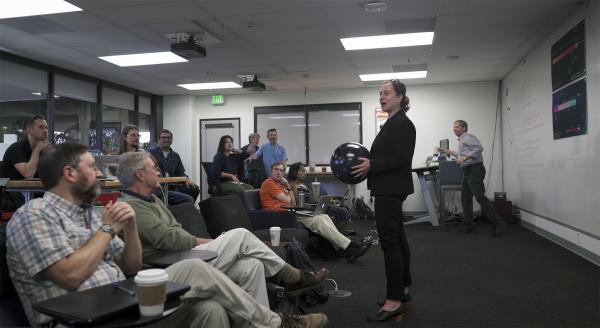This is the second installment of our Q&A with Art + Technology Lab grant recipient Julia Christensen. A few weeks ago, Julia participated in a special meeting at Jet Propulsion Laboratory (JPL) to envision an artwork for a long-term interstellar space mission. On November 1, Christensen will be "in residence" at LACMA to talk with engineers, artists, curators, and the public about the meeting and about her artist project Upgrade Available. The Art + Technology Lab will also be hosting a conversation with Christensen and JPL scientist Dr. Anthony Freeman on Sunday, October 28.
Tell us about your meeting at JPL.
At JPL, when scientists want to develop a major proposal from a kernel of an idea, they hold what they call the Advanced Architecture Study, otherwise known as the “A-Team” meeting. The idea is to get experts from a range of fields into a room together for a full day of structured brainstorm activities; these exercises are designed to really look at an idea from every angle possible. Dr. Anthony Freeman, director of the Innovation Foundry, and Paul Propster, a strategic planner/proposal lead at JPL, proposed that we hold an A-Team meeting to develop my ideas for an art project to be embedded on the spaceship concept Freeman has been developing to travel to Proxima b, an exo-planet in the Alpha Centauri star system, 4.2 light years away.
For our A-Team meeting, we included experts from a variety of disciplines, including exo-planetary science, systems engineering, aerospace engineering, mechanical engineering, artificial intelligence, jet propulsion, science and technology history, and interstellar space. I am still reeling from the sheer amount of idea generation that happened that day––we brainstormed about everything from how we would potentially communicate with the ship in the year 2109, to how an artwork aboard the ship would be interpreted by our as-of-yet-unknown cosmic neighbors. I am still working through pages of notes, dozens of images, and lots of memories to develop our next steps.
It seems like there is a lot of overlap between the type of thinking you do as an artist and the work the group at JPL are doing with the Proxima b mission. What was it like to collaborate in this speculative realm with a room full of rocket scientists?
The scientists at JPL are nothing short of visionary––these are the people who dream up Mars Rovers and the Voyager spacecraft, after all. The creative process is not unlike the scientific process, in that both scientists and artists dream up experimental ideas, figure out how to tell the story, and build the experiment, or conditions for the experiment. Artists are given the luxury of not necessarily having to prove an intended outcome; we can set up the experiment and just see what happens, whereas scientists usually need to be working from an articulated hypothesis. This allows artists to be very transparent about the process and emphasize the process as part of the artwork. For me, the A-Team meeting wasn’t just research, it is part of the artistic process of creating this art project about the future, it is part of the art. I think the scientists in the room that day were equally inspired by this creative platform, envisioning science as art, and art as science. Having creative input from such a wide range of scientific perspectives at JPL is such a dream. Our dialogue that day was incredibly generative; we collaboratively brainstormed about what stories this interstellar science and art can tell.
How has the work you are doing changed the way you think about our place here on Earth as well as in the universe?
The challenge of imagining an artwork that will upgrade itself and evolve over decades aboard a starship headed to a potentially habitable planet orbiting our nearest star, Proxima Centauri, is one of the most expansive challenges I’ve ever had as an artist. While it has led me to think very deeply about our place in the broader interstellar cosmos, it has also led me to think very deeply about how we dwell on this planet, Earth. When I take a walk these days, I see the glorious features of this planet in contrast to the red dust of Mars, or the chilly surface of Proxima b. Perhaps the dialog around this interplanetary research and artwork can make clear that Earth, actually, is the planet of our wildest dreams. We, too, are astronauts, spinning around on a pretty glorious “pale blue dot” in outer space.
The Art + Technology Lab is presented by:
The Art + Technology Lab is made possible by Accenture, Snap, Inc., and DreamWorks Animation.
Additional support is provided by SpaceX and Google.
The Lab is part of The Hyundai Project: Art + Technology at LACMA, a joint initiative exploring the convergence of art and technology.
Seed funding for the development of the Art + Technology Lab was provided by the Los Angeles County Quality and Productivity Commission through the Productivity Investment Fund and LACMA Trustee David Bohnett.




